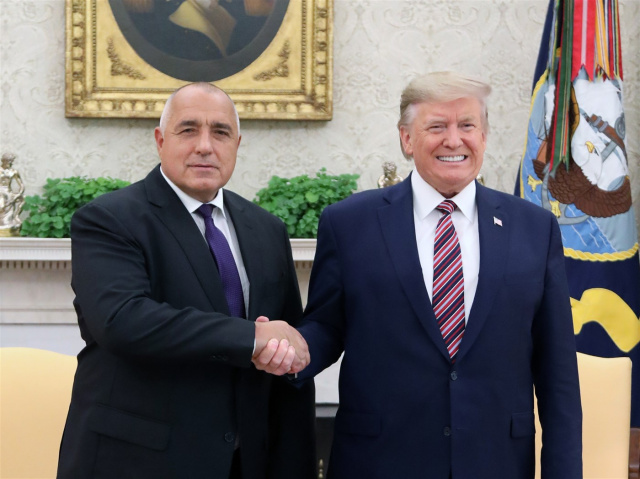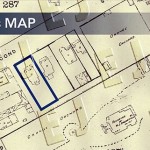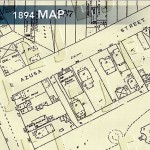13 Titles and Resources at Flower Pentecostal Heritage Center
April 30, 2023 by Cup&Cross
Filed under Featured, News, Publication, Research

160,000 Pentecostals in Bulgaria Reported by the NEW Encyclopedia of Global Pentecostalism

The Forgotten Azusa Street Mission: The Place where the First Pentecostals Met
For years, the building on Azusa Street has also been an enigma. Most people are familiar with the same three or four photographs that have been published and republished through the years. They show a rectangular, boxy, wood frame structure that was 40 feet by 60 feet and desperately in need of repair. Seymour began his meetings in the Mission on April 15, 1906. A work crew set up a pulpit made from a wooden box used for shipping shoes from the manufacturer to stores. The pulpit sat in the center of the room. A piece of cotton cloth covered its top. Osterberg built an altar with donated lumber that ran between two chairs. Space was left open for seekers. Bartleman sketched seating as nothing more than a few long planks set on nail kegs and a ragtag collection of old chairs.
What the new sources have revealed about the Mission, however, is fascinating. The people worshiped on the ground level — a dirt floor, on which straw and sawdust were scattered. The walls were never finished, but the people whitewashed the rough-cut lumber. Near the door hung a mailbox into which tithes and offerings were placed since they did not take offerings at the Mission. A sign greeted visitors with vivid green letters. It read “Mene, Mene, Tekel, Upharsin” (Daniel 5:25, kjv), with its Ns written backwards and its Ss upside down. Men hung their hats on exposed overhead rafters where a single row of incandescent lights ran the length of the room.
These sources also reveal that the atmosphere within this crude building — without insulation or air conditioning, and teeming with perspiring bodies — was rank at best. As one writer put it, “It was necessary to stick one’s nose under the benches to get a breath of air.”
Several announced that the meetings were plagued by flies. “Swarms of flies,” wrote one reporter, “attracted by the vitiated atmosphere, buzzed throughout the room, and it was a continual fight for protection.”
A series of maps drawn by the Sanborn Insurance Company give a clear picture of the neighborhood. The 1888 map discloses that Azusa Street was originally Old Second Street. The street was never more than one block in length. It ended at a street paving company with piles of coal, along with heavy equipment. A small house, marked on the map by a “D” for domicile, sat on the front of the property with the address of 87. (See highlighted section.) A marble works business specializing in tombstones stood on the southeast corner of Azusa Street and San Pedro. Orange and grapefruit orchards surrounded the property. On the right of the map a Southern Pacific railroad spur is clearly visible. The City Directory indicates that the neighborhood was predominantly Jewish, though other names were mixed among them.
A second map of the property was published in 1894. Old Second Street had become Azusa Street, and the address had been changed to 312. The house had been moved further back on the property where it served as a parsonage. The dominant building at 312 Azusa Street was the Stevens African Methodist Episcopal Church. At the front of the building a series of tiny parallel lines on the map mark a staircase that stood at the north end of the building providing entry to the second floor, the original sanctuary.
The only known photograph of the church from this period shows three interesting features. First, it shows the original staircase. Second, and less obvious, the original roofline had a steep pitch. Third, three gothic style windows with tracery lines adorned the front wall.
By 1894, the citrus groves had largely disappeared. On the southern side they were replaced by lawn. The smell of orange blossoms and the serenity of the orchard were rapidly being replaced by the banging of railroad cars and the smell of new lumber. A growing number of boarding houses and small businesses, including canneries and laundries, were moving into the immediate area by this time. The property marked “YARD” on the map is the beginning of the lumberyard that soon came to dominate the area. The City Directory reveals fewer Jewish names, and more racial and ethnic diversity in the neighborhood, including African Americans, Germans, Scandinavians, and Japanese.
Stevens AME Church occupied the building at 312 Azusa Street until February 1904 when the congregation dedicated a new brick facility at the corner of 8th and Towne and changed their name to First AME Church. Before the congregation could decide what to do with the property on Azusa Street, however, an arsonist set the vacant church building on fire. The structure was greatly weakened, and the roof was completely destroyed. The congregation decided to turn the building into a tenement house. They subdivided the former second-floor sanctuary into several rooms separated by a long hallway that ran the length of the building. The stairs were removed from the front of the building and a rear stairwell was constructed, leaving the original entry hanging in space. The lower level was used to house horses and to store building supplies, including lumber and nails.
In 1906, a new Sanborn Map was published. (See 1906 map.) The building was marked with the words “Lodgings 2nd, Hall 1st, CHEAP.” The transition of the neighborhood had continued. The marble work still occupied the southeast corner of Azusa Street and San Pedro, but a livery and feed supply store now dominated the northeast corner. A growing lumberyard to the south and east of the property now replaced the once sprawling lawn. A Southern Pacific railroad spur curved through the lumberyard to service this business.
The Apostolic Faith, the newspaper of the Azusa Street Mission between September 1906 and June 1908, later referred to the nearby Russian community. Many of these recent immigrants were employed in the lumberyard. They were not Russian Orthodox Christians as one might guess; they were Molokans — “Milk drinkers.” This group had been influenced by some of the 16th-century Reformers. They did not accept the dairy fasts of the Orthodox Church. They were Trinitarians who strongly believed in the ongoing guidance of the Holy Spirit. Demos Shakarian, grandfather of the founder of Full Gospel Business Men’s International, was among these immigrants who were led to Los Angeles through a prophetic word given in 1855.
Henry McGowan, later an Assemblies of God pastor in Pasadena, was a member of the Holiness Church at the time. He was employed as a teamster. He timed his arrival at the nearby lumberyard so he could visit the Mission during its afternoon services.
This map suggests why some viewed the Mission as being in a slum. A better description would be an area of developing light industry.
In April 1906, when the people who had been meeting at the house at 214 North Bonnie Brae Street were forced to move, they found the building at 312 Azusa Street was for sale. The photograph below taken about the time that the congregation chose to move into the building shows the “For Sale” sign posted high on the east wall of the building, as well as the rear of the tombstone shop. Seymour, pastor of the Azusa Street Mission, and a few trusted friends met with the pastor of First AME Church and negotiated a lease for $8 a month.
An early photograph reveals what the 1906 version of the map indicates. The pitched roof had not been replaced. The building had a flat roof. The staircase that had stood at the front of the building had been removed.
In a sense, this building suited the Azusa Street faithful. They were not accustomed to luxury. They were willing to meet in the stable portion of the building. The upstairs could be used for prayer rooms, church offices, and a home for Pastor Seymour.
Articles of incorporation were filed with the state of California on March 9, 1907, and amended May 19, 1914. The church negotiated the purchase of the property for $15,000 with $4,000 down. It was given the necessary cash to retire the mortgage in 1908. The sale was recorded by the County of Los Angeles on April 12, 1908.
25 Years ago, I left D.C. and Never Looked Back…

ALIVE
“When I call to remembrance the unfeigned faith that is in thee, which dwelt first in thy grandmother Lois, and thy mother Eunice; and I am persuaded that in thee also.”
2 Timothy 1:5
My Grandma, Todorka Mindova, was one of the first Sunday school teachers in the Bulgarian Pentecostal Union. After successfully graduating from a training course in the city of Sliven led by Donka Kinareva and personally organized by Dr. Nicolas Nikolov, she was allowed to minister in the denomination. But for grandma, the faith was more than teaching or a sermon. It was life. Many Bulgarian Pentecostal ministers can testify to the effectiveness of her ministry. And for her constant fasting and thousands of answered prayers I could write a book.
But far more interesting for me as a child was the fact that being a Sunday school teacher, Grandma never tried to preach to me. In the hardest moments of life she would only confess these words, which I have remembered from my childhood: “We serve a living God.” More was not needed. For Grandma preached with her life. Read more
Pentecostal Seminary Address
5th postpandemic elections in Bulgaria for an expert-government

- exPM Borissov wins (26.51%) once again with a mere 1.5% lead
- CHANGE political formation follows closely with 24.54%
- None have enough to form a majority government and will be forced to seek political coalition
- Merely 1/3 of Bulgaria’s population voted, tired of now 5 consecutive elections since 2021 without a wining ruling party or actual government formed as following:
- 2021 April National Parliament election
- 2021 Second National Parliament election
- 2021 Third National Parliament and Presidential elections
- 2022 October elections for 48th National Assembly after the fall of a four-party coalition in June 2022.
- 2023 Fifth National Parliament elections
CEC data as of 5:55 p.m. with 100% of sectional protocols processed in the Regional Election Commissions show that six political formations will enter the 49th National Assembly: GERB – SDS, WCC-DB, “Vazrazhdane”, DPS, BSP and ” There Is Such a People”.
GERB – SDS have 26.51%, or with a 1.93% lead over WCC-DP, which received 24.54% of the votes. The difference between the two leading coalitions is 49,769 votes.
The GERB-SDS coalition improved its result and received 34,734 votes more than in October last year. Now there are 669,361 people who voted for them.
Nearly 2 percent lag behind the first and second according to the results are “We Continue the Change – Democratic Bulgaria” (WCC-DB). They gathered the support of 619,592 voters, but compared to October last year, a drop of nearly 74,000 votes was reported, as the two formations then gathered the total support of 692,000 voters. If we add the percentages of the two formations from October, they are 27.6 percent, but already as a coalition they achieve a 3 percent lower result.
The third political force in yesterday’s elections is the “Vazrazhdane” (Revival) party with 14.15%, followed by the Movement for Rights and Freedoms (DPS) with 13.72% and the Bulgarian Socialist Party (BSP) – with 8.94%.
“There Is Such a People” (TISP) also entered the new parliament, with the party receiving 4.11% of the vote. The trend of the “Vazrazhdane” party, which from the fourth to the third political force, is upward. Now, compared to October, it adds another 102,000 votes to its result, with 357,167 people voting for the formation yesterday.
The results for DPS, compared now and from last year, mark a drop of almost 2 thousand, and the party from third is now fourth. In October, more than 344,000 people voted for DPS, and 346,437 did so a day ago.
For BSP – fifth in terms of results, the support is also falling – from 233 thousand in October to 225 thousand now, which is minus 7 thousand votes.
103,641 voters voted for the sixth formation, which with a high degree of probability falls into the 49th National Assembly – “There Is Such a People”, and in the previous elections, when Trifonov’s party failed to cross the 4 percent barrier, the support was 96 thousand.
The “Bulgarian Rise” party – had 3.08% and the coalition “Levitsata!” (The Left) remain below the 4 percent barrier. – with 2.24%.
Central Election Commission data with processed 100% protocols in the Regional Election Committees of the country
34 Years after Communism…
34 years in 60 seconds at the red-light…
I’m driving slowly in the dark and raining streets of my home town passing through clouds of car smoke. The gypsy ghetto in the outskirts of town is covered with the fog of fires made out of old tires burning in the yards. And the loud music adds that grotesque and gothic nuance to the whole picture with poorly clothed children dancing around the burnings.
The first red light stops me at the entrance to the “more civilized” part of the city. The bright counter right next to it slowly moves through the long 60 seconds while tiredly walking people pass through the intersection to go home and escape the cold rain. The street ahead of me is already covered with dirt and thickening layer of sleet.
This is how I remember Bulgaria of my youth and it seems like nothing has changed in the past 25 years.
The newly elected government just announced its coalition cabinet – next to a dozen like it that had failed in the past two decades. The gas price is holding firmly at $6/gal. and the price of electricity just increased by 10%, while the harsh winter is already knocking at the doors of poor Bulgarian households. A major bank is in collapse threatening to take down the national banking system and create a new crisis much like in Greece. These are the same factors that caused Bulgaria’s major inflation in 1993 and then hyperinflation in 1996-97.
What’s next? Another winter and again a hard one!
Ex-secret police agents are in all three of the coalition parties forming the current government. The ultra nationalistic party called “ATTACK” and the Muslim ethnic minorities party DPS are out for now, but awaiting their move as opposition in the future parliament. At the same time, the new-old prime minister (now in his second term) is already calling for yet another early parliamentarian election in the summer. This is only months after the previous elections in October, 2014 and two years after the ones before them on May 2013.
Every Bulgarian government in the past 25 years has focused on two rather mechanical goals: cardinal socio-economical reforms and battle against communism. The latter is simply unachievable without deep reformative change within the Bulgarian post-communist mentality. The purpose of any reform should be to do exactly that. Instead, what is always changing is the outwardness of the country. The change is only mechanical, but never organic within the country’s heart.
Bulgaria’s mechanical reforms in the past quarter of a century have proven to be only conditional, but never improving the conditions of living. The wellbeing of the individual and the pursuit of happiness, thou much spoken about, are never reached for they never start with the desire to change within the person. For this reason, millions of Bulgarians and their children today work abroad, pursuing another life for another generation.
The stop light in front of me turns green bidding the question where to go next. Every Bulgarian today must make a choice! Or we’ll be still here at the red light in another 25 years from now…












